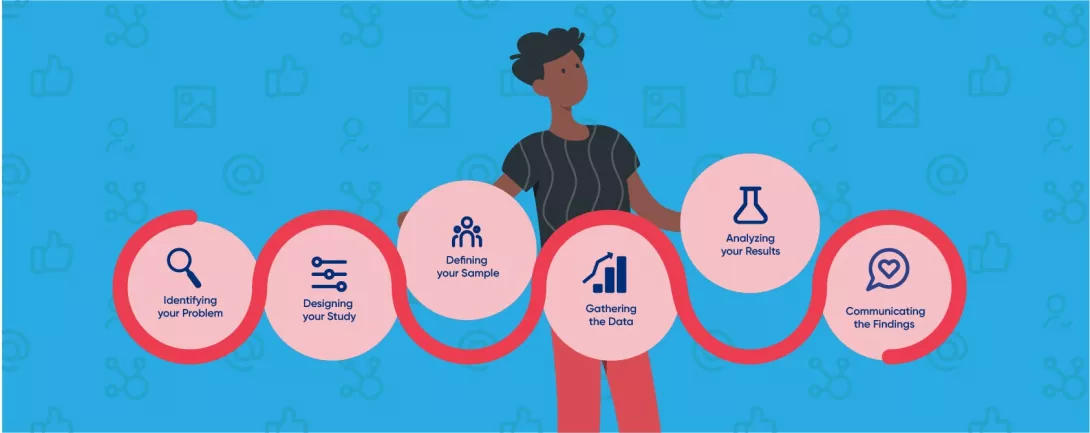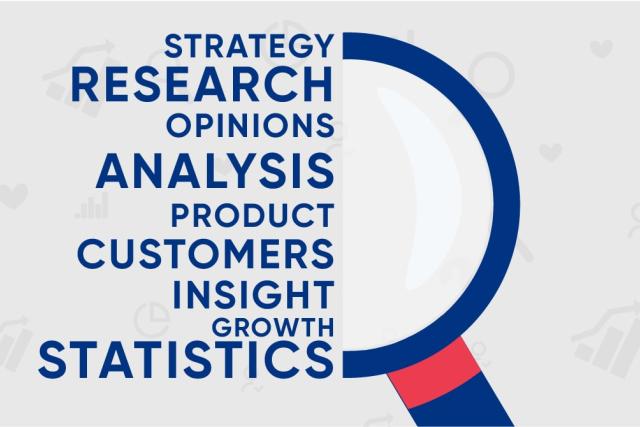
Conducting your market research can seem complicated at first but here are easy steps to help you conduct market research on your own as a startup or new venture.
The key stages you can find in market research includes the following
Identifying your Problem
Designing your Study
Defining your Sample
Gathering the Data
Analyzing your Results
Communicating the Findings
Step 1 – Identifying your problem
In any research, if you cannot clearly define your problem then you will struggle to move forward. The research problem may be obvious most of the time but other times it may take a little more work to identify the problem at hand.
Identifying your problem goes together with defining your hypotheses, as assumptions from yourself or from stakeholders will certainly arise at this step. You can consider hypotheses as "Key questions": once they are defined, it’s easier to choose the questions you want to ask to later validate or invalidate your assumptions. Consider hypothesis definition as a crucial step as it will impact all the following steps.
Before you start defining your problem, remember the following:
- Reach the appropriate stakeholders and users to ensure your focusing on the right problem
- Translate your problem(s) into research objectives to ease internal communication and planification
Pro Tip: One problem at a time!
You shouldn't try to solve all the problems you have identified all at once. It's better to solve one problem at a time, and get deeper with each problem.
Step 2 – Designing your Study
After having identified your research problem, you can start designing your Study. At this stage, you will define the master plan you will rely on for the rest of your research: you have to specify the methods you will use and the duration of each activity. You will also start drafting your research questions and decide which research methods would be the most appropriate to get answers: surveys, secondary data usage or experiments.
Here are some questions to ask yourself that can help you design your study:
What is my data source? Have my questions already been asked in other studies or should I conduct my own survey?
How quick do I need the results?
How precise should my answers be?
How long would my questionnaire be?
Are descriptive findings enough or an experiment would be needed?
Step 3 – Defining your Sample
Either you’re using qualitative or quantitative research methods, you’ll need to define the number of answers you want and thus the number of participants you’ll have to reach. “The more, the better” are you thinking? In reality, when you reach a certain threshold of answers you’ll get enough answers to fit your need. More answers than needed would just be a waste of money.
In quantitative studies, you have to see your sample as a smaller version of the entire population you’re targeting. This “smaller” population has to be big enough to “represent” the entire population: getting answers from your sample should give you the same results (considering a certain level of margin of error) as if you had interviewed the entire population. Thus, your sample will have to respect the same characteristics as your whole population (gender, age range, …). Once again, “The more, the better” is not the best advice to follow when choosing your criteria (gender, age, job, matrimonial status, etc): not all of them would have an influence on your answers, so only choose those that matter.
Therefore, to start defining your sample you’ll need the answers to the following:
How precise do I want the results to be?
What’s the (estimated) size of my target population?
What’s the criteria defining my target population?
Step 4 - Gathering the Data
Now that everything is set, it’s time to collect the answers you need. There are different ways to collect the data and before you start you should ask yourself these 3 questions:
What's my budget?
How fast do I need to get the data?
What’s my available resources (human & time)?
Depending on these answers, you can choose the solution that better correspond to your situation:
Use a survey tool & collect the data by yourself
Use a survey tool & rely on surveyors
Use a crowdsourced based tool
Rely on LOOKA
Rely on an agency
Step 5 – Analyzing your Results
Data is important but a proper analysis of your data is still needed to lead to right decisions: be aware that some results can be tricky and could lead to different interpretations, thus leading to different decisions. Depending on how deep you want to dive into the data, statistical knowledge and software skills would be required to extract the appropriate results and interpret them correctly. Most survey tools have basic data visualization features embeded and will display charts for each of your questions, but if you want to go further you can rely on tools such as excel, excel stat, tableau, Statistical Package for the Social Sciences (SPSS) or Statistical Analysis Systems (SAS).
Step 6 – Communicating the Findings
Finally, you have analyzed all the data acquired but you still need to communicate your findings in written terms and share it with the decision makers. Your results should be presented in a way that is meaningful to your business: don’t stay at a descriptive level (only describing the results) but give propositions of decisions backed by the results. Also try to summarize your results as much as you can and avoid losing your audience into too much detail.
Here are question to ask yourself to help form a useful report:
Who will read my report and what matters to them?
What were my initial hypotheses and research objectives?
What report format works best for my audience?




